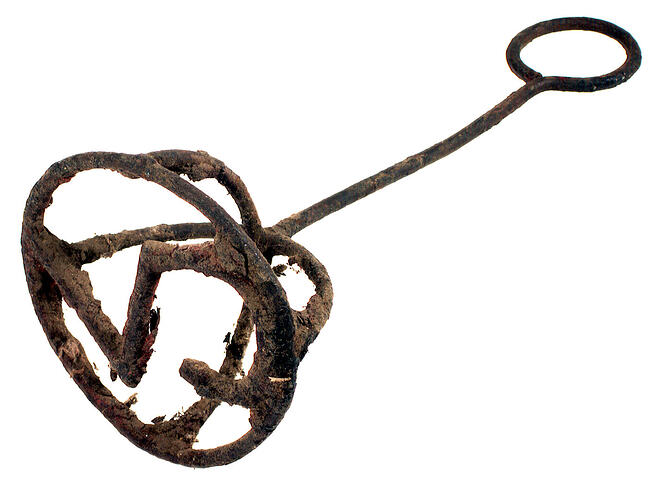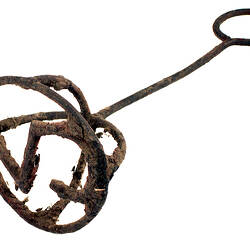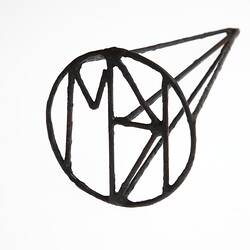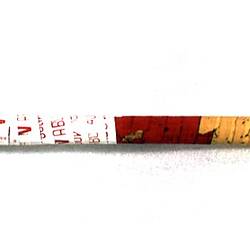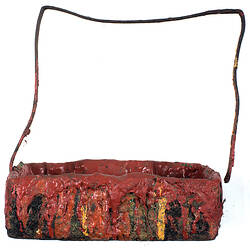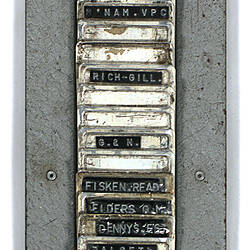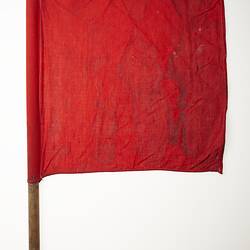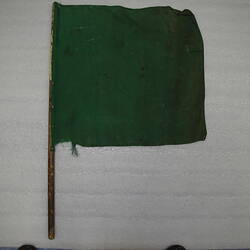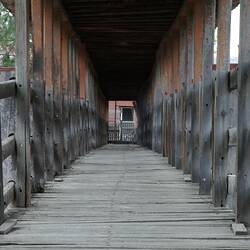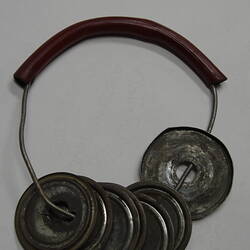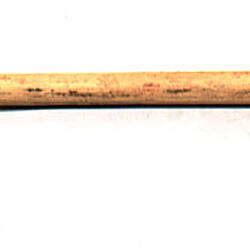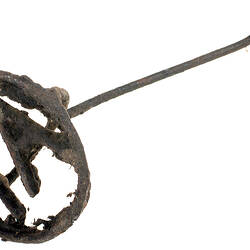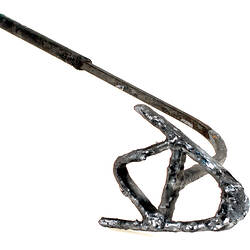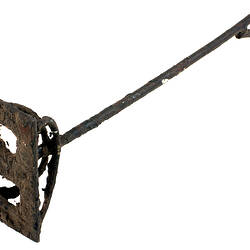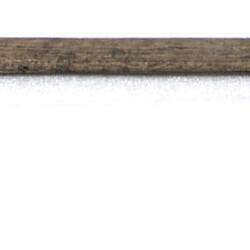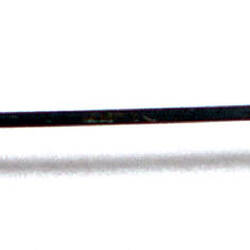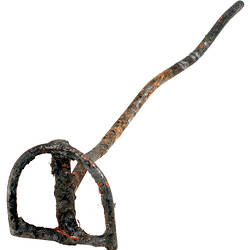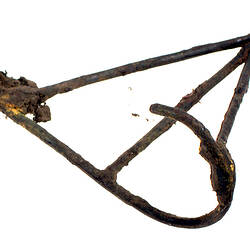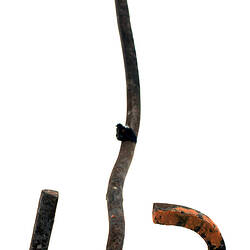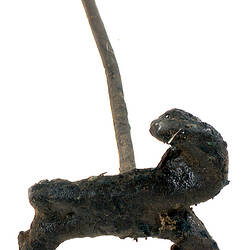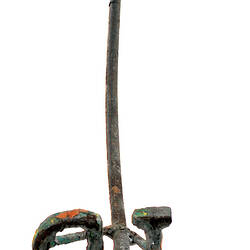Branding Irons or Sticks: Branding Irons or Sticks are tools with the purpose of leaving a mark usually to indicate ownership or to track stock movement. Branding irons at the Newmarket Saleyards were only used with removable materials in order for the hide or fleece to be kept in optimum condition. See Newmarket Collection items SH 900034; SH 900044; SH 900068
Branding Pot: Container or pot used for holding paint to dip cattle brands. At Newmarket paint was used to brand cattle from the 1940s. A branding pot was often found hanging at the lane gateway and stock would be marked as it passed. If the branding pot became too built up with paint, the drovers would put the tin on the fire and burn out the leftover paint remnants. See Newmarket Collection item SH 900078
Cattle and Sheep Race: A narrow corridor built for cattle and sheep to travel through when being moved from one location to another nearby location; or used to sort stock. A race usually consists of parallel panels or fences with a space between them just wide enough for one animal to pass through comfortably without being able to turn around, thus forming the animals into a queue that only allows them to go forward.
Cockie/Cocky: Colloquial term used in Australia and New Zealand to describe a farmer, usually one who has small holdings. Also sometimes referred to as "cow-cocky". The term "cockie" or cockatoo farmer dates back to the Land Selection Acts in the 1880s where small land holdings were made accessible. Folklore suggests that large land-holders, or squatters, disparagingly referred to small land-holders as "cockatoo farmers" because they bought up land like a flock of cockatoos stripping a crop; or suggested that all that could be raised on a few hundred acres was cockatoos. (OED Online. September 2010. Oxford University Press. Nov. 2010 http://dictionary.oed.com/cgi/entry/50042937)
Coffee with a stick in it: Colloquial term that possibly refers to a cup or pot of coffee that is very strong, very sweet or laced with spirits.
Dollars per Head: Until the mid 1970s, stock was sold at auction at Newmarket by open cry on a 'dollars per head' basis. See 'Liveweight Selling'.
Doutta Galla Province: Doutta Galla Province was an electorate of the Victorian Legislative Council from 1937 until 2006. It was abolished from the 2006 state election in the wake of the Bracks Labor government's reform of the Legislative Council. (Parliament of Victoria. Nov 2010 http://www.parliament.vic.gov.au/re-member/bioregsearch.cfm)
Drafter: A person, usually employed by livestock agents, sorting livestock into various categories. Drafters often worked throughout the night to have stock ready for morning sales.
Drover: A person who drives cattle or sheep to market. The drover is an iconic image within Australian folklore and is an integral part of the history of the Newmarket Saleyards. Items often associated with the drover are "Driza-Bone" coats and the ever-reliable drover's dog. See 'Overlander'.
Drover's Hut: A room at the Pastoral Hotel in Newmarket, circa 1900s, that was originally set up to cater for a more exclusive clientele such as agents, executive staff, squatters and others, with a 'penny extra' charged as a levy. Over time, drovers and their dogs occupied the room which acquired the name "The Drover's Hut". Badges were struck to be worn by regular clients. Hotels and Public Houses played an essential role at Newmarket as enduring providers of drink, food, entertainment, and accommodation; and as a welcoming venue to stay warm, keep cool, meet with friends, or conduct business.
Fat Stock: Livestock that has been fattened and ready for market.
Lairage: Accommodation for animals, especially at markets.
Liveweight Selling: Introduced to Newmarket in 1975 whereby cattle were weighed and auctioned on a 'cents per kilogram' liveweight basis. Liveweight selling was recognised as a revolutionary and objective measurement of stock. See 'Dollars per Head'.
Livestock Agents: An agent authorised to sell livestock for a compensation. See Newmarket Collection items SH 900088; SH 900089; SH 900090; SH 900091; SH 900092
Livestock Auction: Organised system for the sale of livestock sold to the highest bidder. See Newmarket Collection item MM 112545
Milch Cow: A cow bred or kept for milking. Variations of the term "milch" were used prior to the 1400s with origins from the Germanic languages. It is also related to the Middle English term "milche" and the Germanic term "melke", meaning "milking". Further suggestions propose the term could have origins in the Old English word "thrimilce" referring to the month of May, the month when cows could be milked three times (thrice) a day. (OED Online. September 2010. Oxford University Press. Nov. 2010 http://dictionary.oed.com/cgi/entry/00309468)
On the Hoof: A term referring to cattle and sheep being droved to market by horseback.
Overlander: Skilled stock men or women who drive sheep and cattle over long distances to market. See 'Drover'.
Post and Rail Fence: Fence constructed using vertical posts and horizontal rails. See Newmarket Collection items MM 112551; MM 112552
Prayers: Colloquial jargon used to describe the reading of Conditions of Sale by the clerk or auctioneer prior to each livestock auction.
Rattler: Device, usually hand-made, that made noise and was used to herd sheep.
Rung Off: Colloquial term used to identify an auctioneer prevented from completing the sale within the strict time limit that was imposed on livestock auctions.
Saltwater River: Term used for the Maribyrnong River by early European settlers before its present name came into common usage; named due to the tidal nature of its lower reaches. The Maribyrnong River runs through a valley that was originally home for the Wurundjeri people of the Kulin nation.
Stock Pass: A paper 'pass' or 'ticket' that indicated the number of animals (cattle or sheep) delivered to pens and taken out of the yards. The number on the pass was required to tally with a the number counted by the Melbourne City Council employee as livestock passed through the market gates. The Stock Pass was used to calculate the yard dues and charges which had to be paid by the Agents to the Melbourne City Council. See 'Yard Dues'.
Stock Route: The Newmarket 'Stock Route' linked various sites of the saleyards complex, with sections being constructed at different times as the complex expanded. It stretched from the former Angliss Meatworks, across the Maribyrnong River, through the Saleyards, over Racecourse Road, and as far north as the railway line. An underpass was constructed along the Stock Route in 1911 to move stock under Epsom Road and became known as "The Back Gate". Two other bridges were built along the Stock Route, the stock bridge over the Maribyrnong River built in 1941; and the McLennan Overpass over Racecourse Road, built in 1964.
Squatter: A person who settled on Crown land to run stock, especially sheep, initially without government permission, but later with a lease or licence.
Turner: Workers who controlled traffic when stock was crossing the roads, often with the assistance of red and green flags. See Newmarket Collection items SH 900070; SH 900071
Yard Dues: Financial dues collected by the Melbourne City Council from Livestock Agents. See 'Stock Pass'.
Yarding Stick: Long, narrow stick often made of cane, used by yardmen, drovers and stock agents. Used to point out cattle being auctioned and to prod cattle for pushing up into pens and drafting into and out of trucks. The sticks were very long (approximately 5 or 6 feet/ 1.5 meters) so that the user would not be kicked. See Newmarket Collection items SH 910288; SH 900035; SH 900037; SH 900036; MM 052669
More Information
-
Keywords
agricultural industry, Working Lives, city & town life, country life
-
Authors
-
Article types
